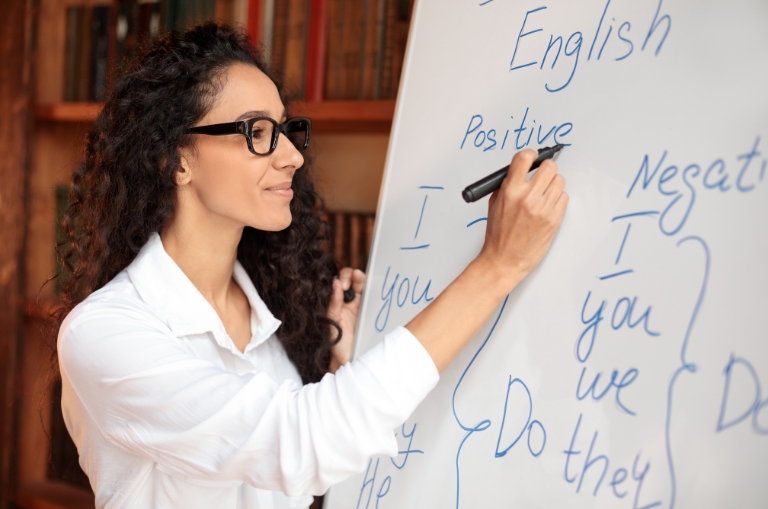There was a time when every classroom had a blackboard. Clouds of chalk dust and the horrible screeching of stale chalk or fingernails scraping down the board were a constant threat. Happily, those days are over for many school children, as whiteboards increasingly take the place of blackboards.
Whiteboards vs Blackboards
Both whiteboards and blackboards have their advantages, Whiteboards are generally clearer than blackboards as they don’t generate dust and can also be used as a backdrop for overhead or film projectors. Many whiteboards are also magnetic, giving them an extra layer of functionality. The chalk used on blackboards is much easier to get out of clothes than a whiteboard marker and makes it easier to draw different thicknesses of line than a marker.
Types of whiteboards
Melamine
A melamine whiteboard is a practical and affordable choice for classrooms. Constructed with a melamine resin surface, it offers a smooth and easy-to-write-on backdrop for teachers and students. The lightweight construction of melamine whiteboards makes them easy to mount on classroom walls and reposition as needed. They are also budget-friendly, making them a cost-effective option for schools with limited budgets.
While melamine whiteboards are more prone to staining and ghosting compared to other materials, with regular cleaning and proper care, they can still provide a reliable tool for classroom communication and collaboration. The lightweight nature and low price of melamine whiteboards make them an affordable and convenient solution for schools.
While they may require more attention for maintenance, melamine whiteboards can still serve as effective tools for classroom instruction and student engagement.
Painted steel
A painted steel whiteboard is a durable and versatile choice for classrooms. Constructed with a steel surface coated in high-quality paint, painted steel whiteboards offer a smooth and receptive writing surface perfect for interactive learning. The magnetic properties of painted steel whiteboards allow for easy attachment of visual aids, posters, and worksheets, promoting a dynamic and engaging classroom environment.
Painted steel whiteboards are known for their longevity and resistance to scratching, ensuring they can withstand the demands of daily classroom use. It’s important to note that over time, the painted surface may be susceptible to scratching and staining if not handled with care. Despite this, with proper maintenance and regular cleaning, painted steel whiteboards can provide a reliable tool for effective communication and collaboration in the classroom.
The durability of painted steel ensures they can withstand the rigors of daily use by students and teachers, but they are quite heavy so aren’t as easy to install or move as melamine.
Porcelain
A porcelain whiteboard is a robust and practical choice for any classroom. Constructed with a smooth porcelain enamel surface, it offers exceptional durability, ensuring long-lasting use even in the most active learning environments. Its non-porous design resists scratches, stains, and ghosting, providing a clean and clear canvas for teachers and students to brainstorm and illustrate ideas.
Porcelain whiteboards have a magnetic metal backing, allowing for easy attachment of visual aids, posters, and worksheets, enhancing engagement and interactive learning. It’s important to consider that porcelain whiteboards can be more expensive than other options. Nevertheless, the investment pays off with their exceptional longevity, low maintenance, and ability to withstand the rigors of daily classroom use, making them a valuable tool for educators and students alike.
Glass
Glass whiteboards feature a toughened safety glass surface attached to a white metal backing. The glass surface is non-porous, making it resistant to stains, ghosting, and scratches, ensuring a pristine backdrop for teaching and collaboration. It’s worth noting that glass whiteboards can be a bigger investment compared to others. While the durability of tempered glass makes it resistant to breakage, glass whiteboards may still be more delicate compared to other materials, requiring careful handling to avoid any accidents in the classroom.
The benefits of a glass whiteboard in the classroom are numerous. The sleek and modern design adds an aesthetic appeal to the learning environment, creating an engaging and visually appealing space for students. The smooth glass surface also provides an effortless writing experience, allowing teachers and students to express their ideas with clarity and ease.
Many glass whiteboards also feature a magnetic backing, though the thickness of the glass front may require the use of rare earth magnets instead of regular magnets due to their increased strength.
The glass surface is easy to clean and maintain, ensuring a hygienic environment for students. The only downside to consider is the higher cost and the need for cautious handling. Nonetheless, the overall durability and visual impact of a glass whiteboard make it an attractive option for classrooms seeking a contemporary and functional teaching tool.
Whiteboard Formats
In addition to the different styles of whiteboard construction, there are also a number of whiteboard formats that may be used in schools.
Mounted
This style of whiteboard must be mounted on a wall in a classroom. Mounted whiteboards provide a set focal point for classes, promoting student engagement and serving as a versatile tool for teachers to illustrate concepts. A potential drawback of a mounted whiteboard is the limitation of space and the fixed position, which may restrict mobility or flexibility in classroom arrangements.
Mobile
A portable or mobile whiteboard in a classroom offers the advantage of flexibility and mobility, allowing teachers to easily move and position it wherever needed to facilitate dynamic and interactive lessons. Many movable or portable whiteboards are also double sided, allowing teachers to prep additional lessons or reveal additional information.
Portable whiteboards are convenient for storage and can be shared between classrooms, but a potential drawback is the need for additional space to store the whiteboard when not in use, as well as the possibility of it being less stable compared to mounted whiteboards.
Individual/Personal
Each student having their own personal whiteboard allows for independent practice, immediate feedback, and a sense of ownership over their work. Individual whiteboards are typically made with melamine, so they do require frequent cleaning to avoid staining and ghosting.

